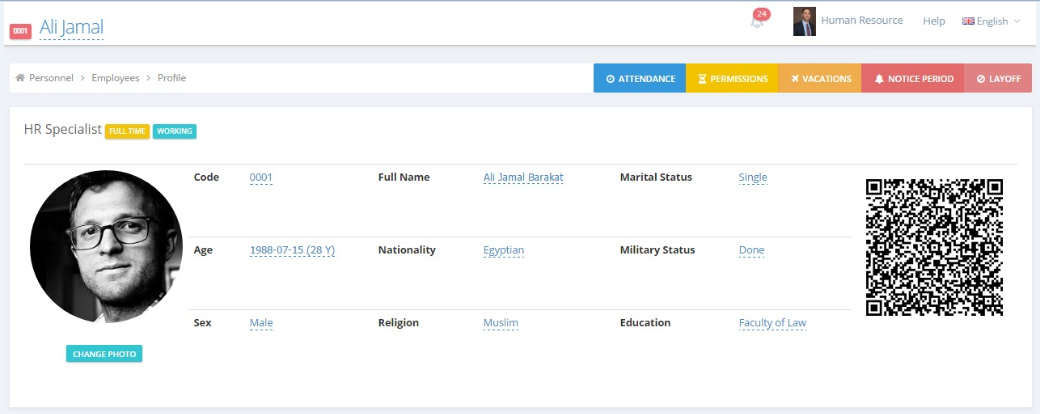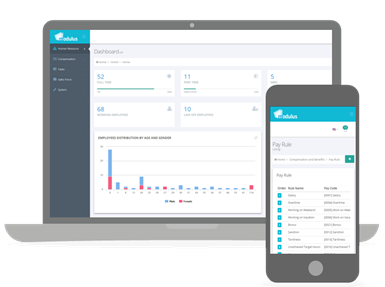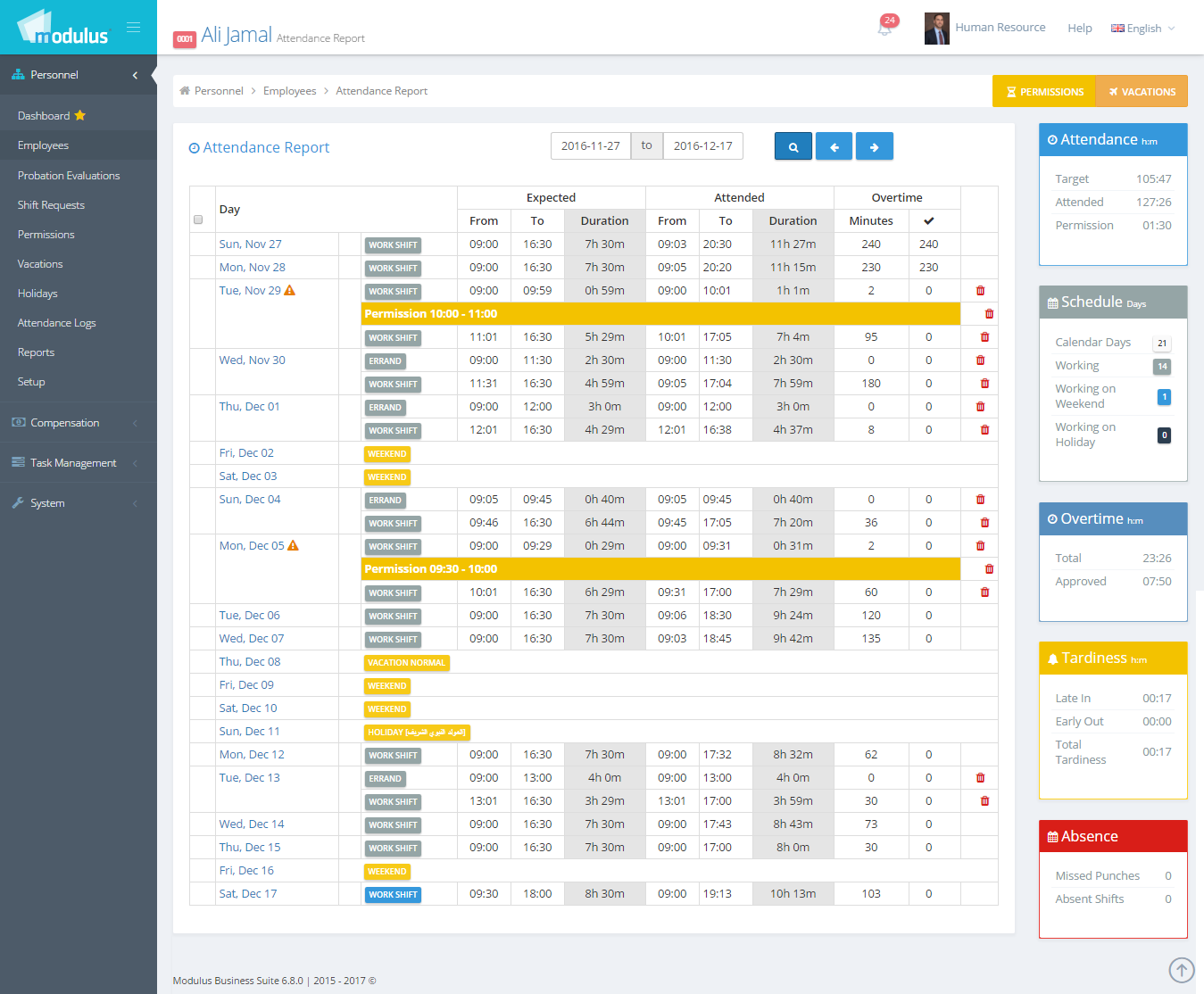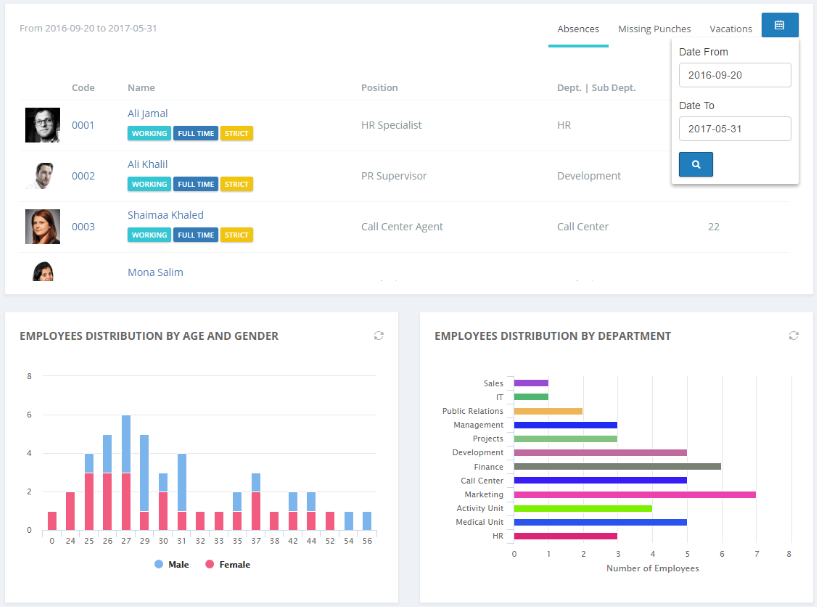Personnel Module
The personnel module is designed to be extremely flexible to adapt different business industries. It offers multiple user levels to cover all personnel management related functionalities such as:
- Manage Employee Profile
- Track
- Vacations
- Holidays
- Shifts
- Permissions
- Attendance
- Reporting
- Attendance Report
- Vacation Consumption
- Vacation Balances
- Schedule Logs
- Setup
- Departments/Sub Departments
- Positions
- Schedule Templates
- Vacation Types
- Probation Questions
- Integration with Attendance Devices
- Absence
- Missed Punches
- Stability Indicators
- Turn Over Rate
- Voluntary Turn Over Rate
- Retention Rate
- Average Tenure for Workers
- Average Tenure for Leavers
- Employees Distribution by Department
- Employees Distribution by Attendance Scheme
- Employees Distribution by Age and Gender
1. Employee Profile

- Basic Info
- Employment Info: All the employment info such as department, position, contract…etc.
- Financials: Employee’s salary items in detail.
- Insurance: Employees insurance info, which will be used in the payroll module when calculating the insurance amount.
- Logs: Shows you every single change that happens the employee.

Insurance and Financial functionalities are available only if the CAB module is activated.
2. Calendar Templates
Modulus allows you to define calendar templates for each employee and every month a new attendance schedule is defined for the employee based on his assigned calendar. The purpose is to define to the application when the employee is expected to come and leave.
The expected working hours per month is calculated based on the attended hours; they are not absolute.
The HR Supervisor and Employee’s Direct Head have the ability to edit the employee schedule.
3. Attendance
The attendance is the actual attended hours by the employee. Modulus adapts for different attendance schemes such as:
- Strict: Employees are expected to attend and leave in a strict times. In case of any delay, tardiness policy applies.
- Flex: Employees are expected to attend in a certain time, but some flex minutes are allowed. These flex minutes must be compensated by the employee during the month.
- Daily Target: Employees are expected to attend a specific amount of hours during per day. If they didn’t meet the target, policy applies.
- Monthly Target: Employees are expected to attend a specific amount of hours per month. If they didn’t meet the target, policy applies.
- Management by Objectives (MBO): Employees are not expected to attend at all. It is useful for top management and CEOs.
4. Vacations
Modulus allows you to dynamically define vacation types, for each type you can define:
- Vacation Name
- Coverage (%): The percent covered by the company. The company can cover a defined portion from the vacation days.
- Days Before Entitlement: Number of days that the employee must spend in the company before asking for this type of vacation.
- Max Consumption (Days)
- Balance Reset: Whether the balance is reset annually or not.
- Allow Request: Whether the employee is allowed to send request from the Self Services module or not.
5. Shifts and Permissions
A Shift is the working duration that the employee is committed to spend in the company, whether it is attended (i.e. working shift) or non attended (i.e. errand).
Permissions are period of time usually between one hour and four hours per month given to the employee as a benefit. Modulus allows ordering permissions from Employee self services and the direct head can approve or reject them without any involvement from the HR department. You may define permissions to be compensated by the employee or not.
6. Probation Evaluation
After the probation period is over (configurable amount of time) a form appears to the head who selected the candidate and a set of questions (configurable) is asked to him and according to his answer he gives a recommendation either to keep the candidate or sack him.
This is very useful to be able to know who can judge and who can’t from your employees.
7. Import Attendance Logs
Real attendance logs can be either imported from attendance sheet, or you can setup direct integration between your attendance device and modulus APIs so that attendance logs are automatically reflected to corresponding attendance reports.
8. Dashboard
The dashboard is a centralized reporting where HR manager can view the company’s performance from HR perspective.




